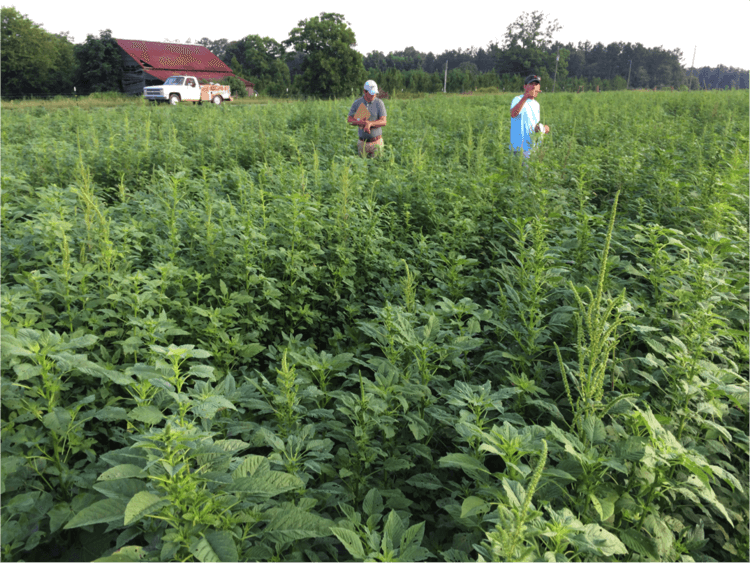The key to glyphosate-resistant Palmer amaranth control is a comprehensive, integrated weed-management strategy emphasizing resistance management.
It’s been called a superweed, a crop robber and the cotton industry’s most destructive adversary since the boll weevil. Palmer amaranth (Palmer’s pigweed, carelessweed) is a zero-tolerance nuisance that can choke out crops, destroy farm equipment and require costly or labor-intensive management that can be unsustainable.

Palmer amaranth infesting a North Carolina cotton field in 2014
The formidable weed can grow as high as ten feet and a single plant in competition with cotton can produce almost a half million seeds.1 It is drought tolerant, thrives in high temperatures and grows very quickly resulting in tall, thick stands that quickly dwarf other vegetation. Palmer amaranth can slash yields and profits when it gets out of control; the only resort is costly hand-pulling and the weed's thick stems and extensive root system make that a difficult task. In the worst cases, Palmer has forced many growers to simply abandon the crop because it got so out of control. Palmer amaranth is a weed that requires 99.9% control as 90% control just isn’t good enough.

Palmer amaranth in research trials in Georgia
In 2004, the first glyphosate-resistant Palmer amaranth was discovered in Georgia.2 Today, the weed variation is widespread in the southeastern U.S. and cases have been reported in Texas, Virginia and Indiana.3 Due to the rapid proliferation of glyphosate-resistant Palmer amaranth, herbicide costs in the cotton industry soared from around $23/acre in 2004 to $100/acre by 2012.4 In addition to the $15 million spent on labor to hand-weed rows of cotton, farmers in Georgia alone spent well over $100 million fighting one weed in one crop.2 The explosive proliferation of glyphosate-resistant Palmer amaranth sent growers, agents and researchers in search of an alternate compound with a different mode of action.
The key to glyphosate-resistant Palmer amaranth control is a comprehensive integrated weed management strategy. Brake can be used as the foundation residual treatment in such a program. Brake provides excellent Palmer amaranth control with very good longevity and is a great complement to the overall weed control system. In a typical Brake program, a total of up to five to eight different modes of herbicide action can be used as part of a comprehensive resistance management strategy.
1. "The Biology and Ecology of Palmer Amaranth: Implications for Control,” Sosnoskie, Webster, Culpepper and Kichler, caes.uga.edu, February 1, 2014.
2. "Pigweed in the Cotton: A ‘Superweed’ Invades Georgia,” Andre Gallant, modernfarmer.com, July 18, 2013.
3. “Palmer amaranth Weed Creeping Across Midwest From South,” Steve Karnowski, huffingtonpost.com, October 26, 2013.
4. “Palmer amaranth Tough For Cotton Farmers,” Clint Thompson, caes.uga.edu, June 5, 2013.
